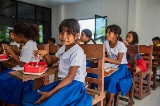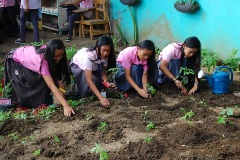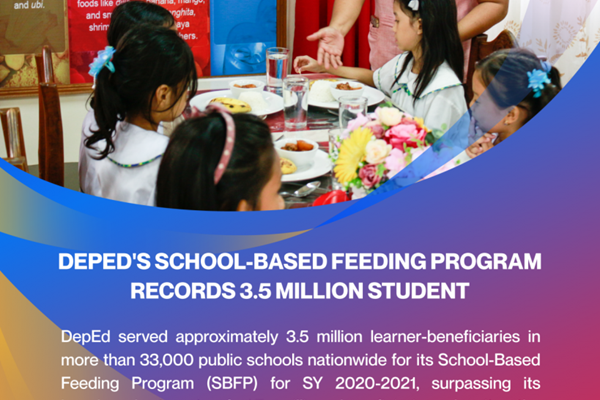School food in the Philippines consists of a school meal programme that targets undernourished pre-primary and primary school children in state schools, providing either healthy meals or nutritious food products. Other types of school food include food sold in school canteens, which are regulated by policy guidelines, or food brought from home.
Food and nutrition topics are primarily integrated within health education as part of one subject known as MPAEH (music, arts, physical education and health), which is compulsory from pre-primary to secondary level (grade 10). Some aspects of food and nutrition are also covered in other subjects, such as agriculture and home economics.
School Food

Since 2004, the Philippines has had a centralized and targeted programme (known as the School-Based Feeding Programme) that provides hot lunches and is managed by the Department of Education through the Bureau of Learners Support Services, School Health Division, known as the Health and Nutrition Centre. It aims to address undernutrition (wasting and severe wasting) among pre-primary and primary schoolchildren (grades 1-6) in state schools, with children identified through nutritional assessments at the beginning and end of the school year. However, depending on funds, the programme might also cover other vulnerable groups such as pupils who are stunted, at risk of dropping out, living in remote areas, living below poverty levels or members of indigenous communities. The programme is part of a broader programme that addresses child malnutrition, food safety issues, nutrition education and some components of school gardens.
In 2017, the Department of Education issued the Policy and Guidelines on Healthy Food and Beverage Choices in Schools and in Department of Education Offices to provide recommendations on what products can be sold in school canteens, and how to increase the availability of nutritious and safe foods. These guidelines set out nutrient criteria for packaged foods (Nutrition Facts must be shown on labels) and a traffic light rating system for non-packaged foods, which are compulsory for all school caterers, as well as for food vendors in and around public elementary and secondary schools. The guidelines also cover Department of Education workplace canteens.
Although these policy guidelines (2017) include some recommendations for planning healthy meals, the school meals are being designed following a 20-day menu cycle (repeated a total of six times) that meets one-third of the recommended nutrient and energy intake for the Philippines Dietary Reference Intakes.
The school meal programme needs to follow operational guidelines, which were updated in 2021 due to challenges relating to COVID-19 and school closures. Temporary adjustments included switching to a 60-day cycle (from 2020-2022) and providing nutritious food products, developed by the Food and Nutrition Research Institute (e.g., fortified/enriched breads and pastries, root crops, local fruits and vegetables in season, eggs, cereals/grains, fortified-blended food and nutri-packs) that would cover one-third of the Philippines Dietary Reference Intake. From 2023, each school will decide whether to continue providing the food products or revert to hot meals, depending on the availability of ingredients, procurement capacity, logistics, human resources, etc. As of 2023, schools that want to serve hot meals will have to rely on volunteers to procure, prepare and cook food. Another recommended strategy is to establish a central kitchen supported by the Local Government Unit, which can prepare and distribute the meals to satellite schools.
Students that are not recipients of the school meal programme can buy food from the school canteens, which is regulated by the policy guidelines on healthy food choices, or they can bring food from home.
The main characteristics of the Policy and Guidelines on Healthy Food and Beverage Choices in schools and in Department of Education Offices (2017) are summarized below:
| Users of the guidance |
|
| School food covered |
|
| Objectives |
|
| Basis | Nutrient-Based |
Development process
The unit within the Department of Education responsible for the school meal programme has developed a sample menu, based on the Nutritional Guidelines for Filipinos. The sample menu is distributed to schools to adapt to regional and local preferences and forms the main basis for developing school meal programme menus.
Additionally, the policy guidelines (2017) were developed in conjunction with the National Nutrition Council, representatives from WHO, the Food and Nutrition Research Institute and representatives from the different divisions and regions across the country, following the WHO nutrient recommended allowance thresholds. The policy guidelines are currently based on a traffic light system, with green, yellow and red categories for non-packaged foods. The Department of Education plans to update the policy to include the nutrient profile model developed by the National Nutrition Council (not yet available).
Implementation
At the school level, the school feeding coordinator is responsible for developing healthy school menus in accordance with the sample menu of the local food products available in the region. The menus are supervised by regional nutritionists as well as by the regional offices of the Department of Education. The central office also reviews the cycle menu to check compliance with the policy guidelines (2017) and operational guidelines (2021).
The central office of the Department of Education is responsible for training health personnel in regional and division offices. These activities include lessons on food safety, food handling, preparation and serving, school gardening, funding, procurement, etc. Health personnel are then responsible for teaching school feeding coordinators and head teachers about food and nutrition aspects.
In some schools, the feeding coordinator or the health personnel conduct nutrition education activities with volunteer cooks (usually parents) on creating nutritious meals, school gardening and healthy eating habits so these are not only practised in schools, but also at home.
Monitoring and Evaluation
The regional offices are responsible for monitoring the policy implementation at the School Division offices, which are in turn responsible for school-level monitoring through regular visits by health officers. School canteen staff check compliance with policy guidelines (2017) regulating the selling and marketing of unhealthy foods and drinks in and around schools. However, it is the head teachers that are responsible for enforcement of the standards that are included; they work with local governments to issue legislation to limit the marketing of unhealthy foods and beverages within at least a 100-metre radius of the school.
At each level of these governing bodies, the Department of Education has forms to be submitted regularly to the central office. In the case of schools, the parents, school heads or the feeding coordinator can report on improvements in the nutritional and health status of schoolchildren (based on nutritional assessments), challenges in complying with and implementing the policy, if the school’s meals are following the menu cycle, etc.
Summary of Guidelines
The Policy and Guidelines on Healthy Food and beverage choices in schools and in DepEd Offices (2017) cover the following aspects:
Food standards for planning healthy meals
A traffic light system to categorize packaged foods
A traffic light system to categorize non-packaged foods/cooked lunches
Recommendations on planning a healthy menu
Recommendation on increasing the availability and accessibility of healthy and safe foods
Recommendations on regulating the sale and marketing of unhealthy foods
School-Based Food and Nutrition Education

Food and nutrition contents in the Philippines are primarily integrated into health education, which is part of one subject with four components known as MAPEH (music, arts, physical education and health). MAPEH is a compulsory subject in the basic education curriculum for pre-primary to grade 10. Nutrition is one of the health content areas and addresses the importance of establishing good eating habits to enhance health and prevent disease. Other related topics include community and environmental health and personal health, which cover food safety and hygiene.
Topics related to food and nutrition are also covered in agriculture and home economics, but not in science subjects. Home economics is compulsory for primary school (Grades 4-6), after which the subject changes to Technology and Livelihood Education (at the secondary school level): both curricula cover practical skills in food preparation and cooking.
| Main Targets |
|
| Main Educators |
|
| Integration within the school curriculum |
|
Development
The health education curriculum was developed by the Department of Basic Education, in 2016, in collaboration with the Department of Science and Technology, which includes the Food and Nutrition Research Institute, the Department of Health which includes the National Nutrition Council, and the Department of Social Welfare and Development. Other experts in nutrition and health from academia were also consulted. During COVID-19, the learning competencies were narrowed down due to school closures, but post-pandemic, the curriculum is being revised with the involvement of schoolteachers, supervisors, school principals and experts in the different learning areas. During the revision process, it was decided the focus would be shifted from food intake and how the body utilizes nutrients for growth, development and health, to a food literacy approach (a wider scope that ranges from food production, procurement, preparation, processing, packaging, and labelling to food choice and consumption).
The revised curriculum is designed to help students develop the self-regulating and social-emotional skills they need to foster overall health and well-being, the skills and knowledge they need to enable them to live active and healthy lives, and the ability to understand the factors that contribute to healthy development, amongst other learning goals. The objective of food literacy is to encourage students to make connections between what they learn in the classroom and what they do in their own lives and to develop a sense of personal responsibility for taking care of themselves by making healthy food choices. As such, students learn to reflect on their food choices and eating patterns and develop personal guidelines for healthy eating while recognizing what they can and cannot control. The new curriculum will be launched in April 2023.
Implementation
The Department of Basic Education is the main entity responsible for implementing the health education curriculum. The Department has developed learning competencies and standards linked to learning materials for each topic, including nutrition, to support teachers who are the main front-line educators. The implementation of the revised curriculum will start in 2024-2025.
The main food and nutrition contents that are addressed in the health education curriculum are:
| Grade | Topic | Content |
| 1 | Nutrition | A. Healthful and less healthful foods 1. Water and milk vs. soft drinks 2. Fruits and vegetables vs. sweets, salty and processed food B. Consequences of eating less healthful food C. Good eating habits 1. Eat regular meals. 2. Eat a healthful breakfast daily. 3. Chew food thoroughly. |
| 1 | Personal Health | Health habits and hygiene 1. Proper behavior during mealtime. 2. Proper hand washing 2.1 before and after eating |
| 2 | Nutrition | A. Healthy Food and the Body 1. Provides energy 1.1 Carbohydrates and Fats 2. Promotes growth and body-building 2.1 Protein 3. Regulates body functions 3.1 Vitamins and Minerals B. Guide in Eating Balanced diet 1. Food Pyramid for Filipino children (7-12 years old) 2. Food Plate for Filipino children (7-12 years old) |
| 2 | Family Health | A. Healthy Family Habits and Practices 1. Sharing responsibilities in keeping the house clean 2. Preparing and eating healthy foods together |
| 3 | Nutrition | A. Good Nutrition and Health 1. Concept of Malnutrition 2. Forms of malnutrition (undernutrition and overnutrition) 2.2. Micronutrient Deficiencies 2.3. Overweight and obesity B. Nutritional Guidelines for Filipinos |
| 3 | Personal Health | A. Concept of health and wellness |
| 3 | Consumer Health | A. Introduction to consumer education and its components (health information, products and services) B. Skills of a wise consumer 1. Budgeting |
| 4 | Nutrition | A. Reading Food Labels B. Food Safety Principles C. Food-borne Diseases |
| 7 | Nutrition | A. Nutrition during adolescence B. Nutritional guidelines C. Nutrition problems of adolescents 1. Malnutrition and micronutrient deficiencies 2. Eating disorders 2.1 Anorexia nervosa 2.2 Bulimia 2.3 Compulsive eating disorder |
A range of information, education and communication materials have been developed to promote key nutrition and gardening messages and to help teachers better incorporate nutrition topics into their daily lesson plans. The Food and Nutrition Research Institute has developed some learning materials, which include a nutrition educator’s kit and a nutrition tool for pre-primary schoolteachers.
Examples of extracurricular activities carried out at the school level include nutrition education sessions for parents and communities during Parent-Teacher Association meetings, cooking demonstrations or recipe development during the annual nutrition awareness month (every July), the use of school gardens as a learning laboratory, etc.
The Department of Education’s Gulayan sa Paaralan has also developed a school garden programme to supplement school meals with micronutrient-rich indigenous vegetables. The main educational learning objective is to serve as a laboratory for learners and inculcate in them the values of gardening, good health, nutrition, love of labour and caring for others. Additionally, as part of efforts to ensure that gains from school interventions are sustained at home, the lighthouse schools initiative is an integrated school nutrition project which serves as learning hubs/models for nearby schools to learn strategies and good practices on the integrated implementation of nutrition education, school gardening and the school meals programme. The project is a collaboration between the International Institute of Rural Reconstruction, the Department of Education and the Food and Nutrition Research Institute-Department of Science and Technology. Since 2018 the programme has been scaled up, using the 58 established lighthouse schools as learning sites for other schools; there are now 273 lighthouse schools and school gardens in 88% of all public primary and secondary schools. These Lighthouse schools also collect relevant data on all three components as evidence for programme recommendations
Monitoring and Evaluation
The Department of Basic Education is responsible for the monitoring and evaluation of food and nutrition contents and has developed grade-level standards (grades 1-10) for the subject of health education. There are learning competences within health education for all topic areas including nutrition. Students are assessed through both written tests, or required to perform different tasks to meet standards, e.g., performance standards for grade 2 students to demonstrate good decision-making skills in choosing healthy food might involve being asked to bring what they think is a balanced meal to school. Teachers are provided with training on how to assess with measurable results.
An intervention study (In 2017-2018) by the Department of Science and Technology-Food and Nutrition Research Institute in nine primary schools showed that a combined school lunch and nutrition education intervention package can improve knowledge, attitude and behaviour scores among mothers and caregivers, and the nutritional status (weight-for-age and height-for-age were used to define underweight and stunting, respectively) among their underweight children aged seven to nine years (grades 2-4). The nutrition education modules developed for the project were based on the Filipino food plate model – Pinggang Pinoy®.
Relevant Links
- FAO in the Philippines
- FAOLEX in the Philippines
- The Right to Food in the Philippines
- Food-Based Dietary Guidelines in the Philippines
Articles

Philippines: How farm-to-school meals are bringing children back to class post COVID-19
02/02/2023
A new WFP-supported project offers healthy, locally sourced school meals, nurturing education and supporting small farmers in vulnerable communities.

Sowing the seeds of potential in a Filipino community
23/02/2018
There is a well-known proverb that says, “It takes a village to raise a child.” But an FAO-led project in the Philippines is proving just the opposite: that sometimes it takes a child – or children – to raise a village.
Around 80 km from Manila, on the south side of the province of Lagun...
News

